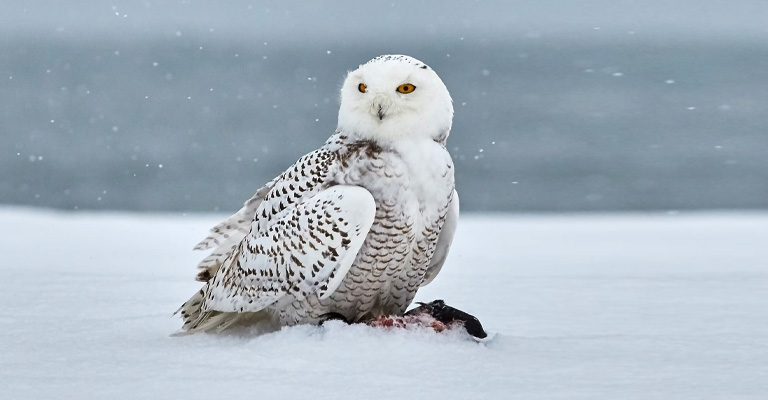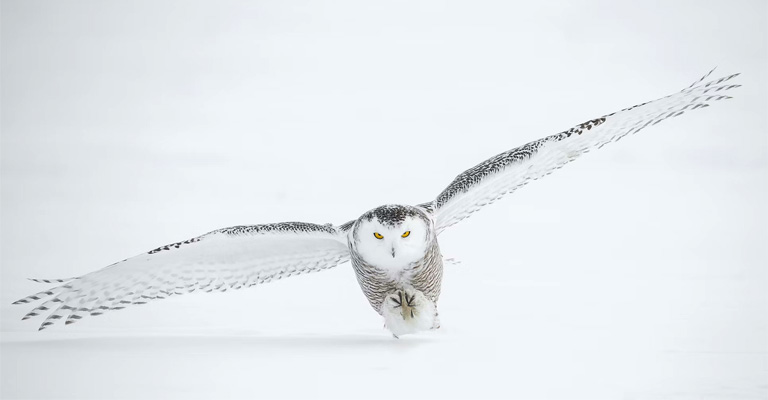Explore the kingdom of animals and birds, and it will leave you breathless at many points. One such remarkable creature is Bubo Scandiacus, which we commonly know as, the Snowy Owl.
How they survive in the coldest and harshest weather – the habitat of the snowy owl is still a wonder to many ornithologists. The Snowy owls are native to the Arctic in North America and Eurasia, where the average winter temperature is about -34° C (-30° F).
So, yes! They must have extreme adapting capabilities to survive and sustain the icy weather. Today, we will explore what’s impossible for a human soul without the right resources.
We will take a deep dive into how the snowy owls turned the brutal snow of the Arctic into their natural territory – the habitat of the snowy owl. Let’s get on board!

Home & Habitat of the Snowy Owl – The Arctic Tundra
The Snowy owls are primarily found in the Arctic tundra. Many of us may not know what the Arctic tundra is. Let us enlighten you first.
Tundra in the Arctic is a large stern landscape spread across the northernmost regions of North America, Europe, and Asia.
The area has developed a unique ecosystem where you won’t find a tree around as far as your sight travels. It basically covers the top of the mountains.
Weather in the Tundra is unforgiving to regular human beings and any other wildlife forms. It’s cold and windy with no rainfall at all. The winter is long and stark.
Where Do the Snowy Owls Live?
The area is large, and no trees to be seen anywhere around. So, where do the owls live? The snow owls are smarter and they widely use the region to their advantage. Follow through as you read,
They are found throughout the Arctic regions of the Northern Hemisphere, including their inhabit areas in Canada, Alaska, Greenland, Scandinavia, Siberia, and northern parts of the United States.
We know many owls and birds build nests in the trees. But in the case of snowy owls, the truth is different. They are often seen in wide expanses of tundra, marshes, coastal dunes, and even airports. The flat surface mimics their natural habitat.
Currently, snowy owls tend to be more visible in our locality. As global warming has become unstoppable, the Arctic is the most affected region of all.
The Arctic ice has started to melt at an unprecedented rate. And, thus disrupting the unique ecosystem of the landscape.
Snow owls are generally known as the nomad birds. They can migrate long distances in search of food especially when the lemming populations crash in their breeding areas.
It is hard for them to survive in our locality with the thick layers of plumage and special physical properties. However, due to climate change, they are moving forward to other locations, looking for a new habitat.
They are still not extinct but if we are not careful, they may soon meet the fate of other endangered species. There’s still time for us to reverse global warming and help them settle in their very own habitat.
How the Snowy Owl Adapts the Savage Cold

The snowy owls are remarkable birds of prey. Their most distinctive features are white plumage and striking yellow eyes. Snowy owls are among the largest owl species (wingspans often spreading five feet), with males typically smaller than females.
It’s fascinating that even their body size helps them out in the cold. It reduces the surface area-to-volume ratio and minimizes heat. In short, their larger body mass allows them to maintain a more stable body temperature in the cold.
Furthermore, they have a thick layer of insulating feathers to cope with the unbearable cold. It helps them withstand almost any subzero temperatures.
Note that, the plumage doesn’t only offer a beautiful white camouflage but also delivers a vital thermal shield. The layer of feathers traps heat close to their bodies, ensuring an essential buffer against the cold.
Additionally, the snowy owls have special blood vessels in their legs and feet. It often acts as a heat exchanger for them and helps prevent heat loss to the freezing surface. This is why they can perch on icy surfaces without any discomfort.
All their body features perfectly allow them to survive in the cold. Now that we are aware of the possibilities of how they can sustain the cold.
Additional Notes:
So far, now we know how the bodies of the snowy owls have developed to survive the brutal cold. Here, let’s learn about how they have managed to nest in the wide cold surface.
Snowy owls typically nest on the ground. They create shallow depressions lined with feathers. Hillocks and ridges are the ideal selection for the snowy owls. It offers them a better vantage point for hunting and helps them stay safe from potential flooding in the tundra.
Hunting Properties:
Although it’s not entirely related to the core context of our article, here’s what you should know.
We genuinely know of the owl species to be purely nocturnal. But, snowy owls present diurnal (daytime) hunting behavior as well. They are crepuscular hunters and are often active during dawn and dusk.
The Arctic environment is mostly responsible for such behavior. During the summer, the Arctic daylight is long and bright.
Are Snow Owls Extinct?
Luckily, they are still not. They are currently classified as a species of “Least Concern” by the International Union for Conservation of Nature (IUCN). However, they do face conservation challenges.
It generally involves climate change, habitat disturbance, or other localization. It’s our duty to ensure they stay safe and build their community into the wilderness of the Arctic.
Final Words
Snowy Owls are not just any birds. They are remarkable and perfectly meant to survive even in the minus temperature.
We should focus on improving the climate and offer a safe earth for them, including other forms of life. It’s our shared world.
Do you like our article? We share regular updates on our avian friends. Stay in touch with us for more. Also, don’t forget to share our article with your friends who are interested in birds.